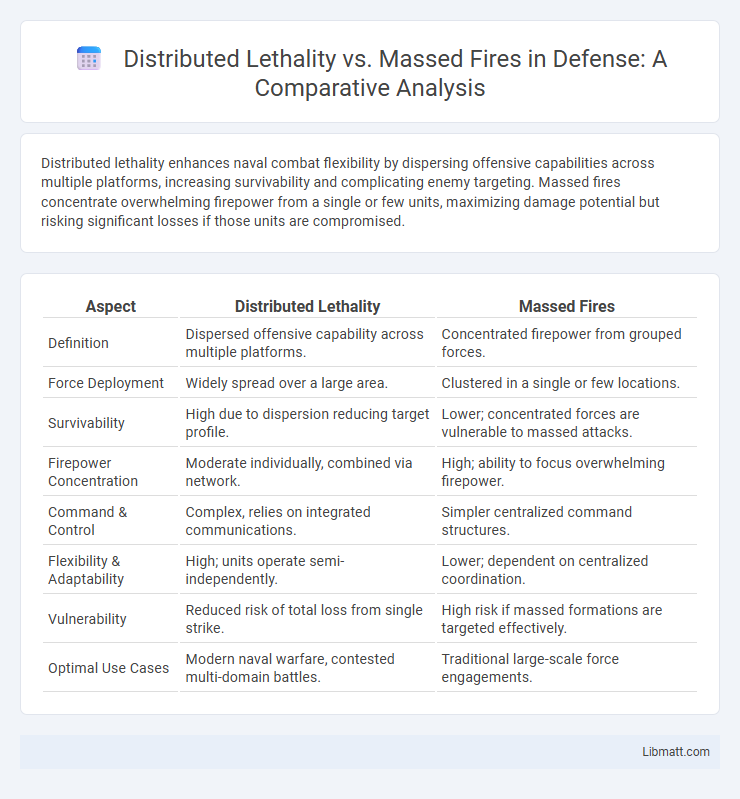Distributed lethality enhances naval combat flexibility by dispersing offensive capabilities across multiple platforms, increasing survivability and complicating enemy targeting. Massed fires concentrate overwhelming firepower from a single or few units, maximizing damage potential but risking significant losses if those units are compromised.
Table of Comparison
| Aspect | Distributed Lethality | Massed Fires |
|---|---|---|
| Definition | Dispersed offensive capability across multiple platforms. | Concentrated firepower from grouped forces. |
| Force Deployment | Widely spread over a large area. | Clustered in a single or few locations. |
| Survivability | High due to dispersion reducing target profile. | Lower; concentrated forces are vulnerable to massed attacks. |
| Firepower Concentration | Moderate individually, combined via network. | High; ability to focus overwhelming firepower. |
| Command & Control | Complex, relies on integrated communications. | Simpler centralized command structures. |
| Flexibility & Adaptability | High; units operate semi-independently. | Lower; dependent on centralized coordination. |
| Vulnerability | Reduced risk of total loss from single strike. | High risk if massed formations are targeted effectively. |
| Optimal Use Cases | Modern naval warfare, contested multi-domain battles. | Traditional large-scale force engagements. |
Introduction to Distributed Lethality and Massed Fires
Distributed Lethality leverages widely dispersed naval forces equipped with potent offensive capabilities to increase agility and complicate enemy targeting. Massed Fires concentrate firepower through coordinated strikes from grouped assets, maximizing impact on critical targets. Your understanding of each concept enhances strategic flexibility in modern naval warfare.
Core Principles of Distributed Lethality
Distributed lethality centers on dispersing offensive firepower across multiple platforms to complicate enemy targeting and enhance survivability, contrasting with massed fires that concentrate weaponry in a single location. Core principles include increasing the number of threat nodes, leveraging networked sensors for real-time targeting, and enabling decentralized command and control to maintain sustained offensive pressure. Your ability to apply distributed lethality ensures a resilient and flexible force posture that outmaneuvers adversaries by diluting their defensive focus.
Fundamentals of Massed Fires Doctrine
Massed fires doctrine emphasizes concentrating multiple artillery and missile systems to deliver overwhelming firepower on a target, maximizing destructive capability and suppressing enemy defenses effectively. This approach relies on synchronized targeting and real-time coordination to achieve rapid, decisive effects over a concentrated area, enhancing battlefield dominance. Understanding these fundamentals helps you appreciate how massed fires contrast with distributed lethality, which prioritizes dispersing forces for flexibility and survivability.
Historical Context: Evolution of Naval and Land Combat
Distributed lethality evolved from Cold War naval tactics emphasizing dispersed, flexible offensive capabilities to counter diverse maritime threats, contrasting with traditional massed fires that concentrated firepower to overwhelm enemies. Land combat has similarly transitioned from large-scale artillery barrages to more agile, networked units capable of precision strikes, reflecting advancements in technology and the need for operational adaptability. Your understanding of these shifts highlights how modern military strategies prioritize decentralized decision-making and rapid response over concentration of force.
Technological Enablers for Distributed Operations
Technological enablers for distributed lethality include advanced command and control (C2) systems, network-centric warfare platforms, and precision-guided munitions that facilitate decentralized targeting and engagement. Enhanced sensor networks and secure communication links support real-time data sharing across dispersed units, increasing situational awareness and operational flexibility. Integration of unmanned systems and AI-driven analytics further amplifies the ability to conduct synchronized distributed operations with reduced risk and increased strike accuracy.
Survivability and Resilience in Modern Warfare
Distributed lethality enhances survivability by dispersing firepower across multiple platforms, reducing the risk of catastrophic loss from concentrated attacks. Massed fires concentrate weapon systems to deliver overwhelming firepower but create higher vulnerability due to clustering of assets, increasing susceptibility to detection and destruction. Resilience in modern warfare is improved through distributed lethality's decentralized command and control, enabling continued operational capability despite enemy targeting or electronic warfare disruptions.
Command, Control, and Communication Challenges
Distributed lethality enhances operational resilience by dispersing firepower across multiple platforms, complicating enemy targeting and reducing vulnerability, but it imposes significant Command, Control, and Communication (C3) challenges due to the need for real-time, secure data sharing and coordination across widely separated units. Massed fires concentrate resources to maximize firepower and simplify command structures, yet face increased risk of detection and disruption, requiring robust centralized C3 systems capable of handling high volumes of information with minimal latency. Effective C3 in distributed lethality demands advanced network-centric warfare technologies and interoperable communication protocols to maintain situational awareness and synchronized engagement, contrasting with the more streamlined but potentially less flexible command systems in massed fires configurations.
Effects on Decision-Making and Tactical Flexibility
Distributed lethality enhances decision-making by dispersing offensive power across multiple platforms, reducing vulnerabilities and diluting the enemy's targeting focus. Massed fires concentrate firepower to overwhelm a specific target quickly but limit tactical flexibility by committing forces to a single point, increasing risk. Your ability to adapt and respond in dynamic combat environments improves significantly with the distributed lethality approach, enabling rapid decision cycles and diversified engagement options.
Impacts on Adversary Deterrence and Escalation
Distributed lethality complicates adversary deterrence by decentralizing firepower across multiple platforms, increasing target ambiguity and survivability. Massed fires deliver overwhelming power from concentrated units, potentially deterring through sheer destructive capability but risking rapid escalation. The strategic choice between distributed lethality and massed fires significantly shapes escalation dynamics by influencing adversaries' risk calculations and decision-making thresholds.
Future Trends and Force Development Considerations
Future trends in distributed lethality emphasize dispersing offensive capabilities across multiple platforms to enhance survivability and complicate adversary targeting, leveraging advancements in networking and autonomous systems. Massed fires continue to provide overwhelming firepower concentration but face challenges in contested environments where survivability and flexibility are critical. Force development considerations prioritize integrating distributed lethal effects with advanced sensors, networked command and control, and adaptive logistics to maintain operational tempo and maximize combat effectiveness in multi-domain warfare.
Distributed lethality vs Massed fires Infographic

 libmatt.com
libmatt.com